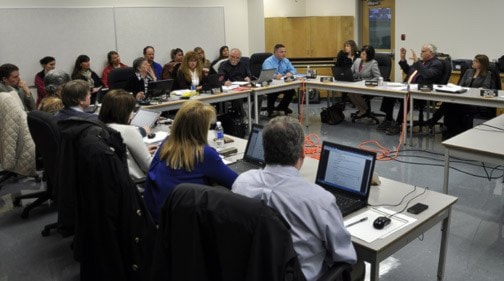A number of Rossland residents were at the school board meeting Monday night in support of a presentation detailing the benefits of keeping K-12 education in the Rossland.
The Neighbourhood of Learning (NOL) committee gave a presentation detailing some of the results of a recent survey. The survey asked residents to give feedback on the various options for future education in Rossland, such as K-7, K-10 of K-12 and what there feeling were on each.
Linda Schultz presented the results which came to the conclusion that making Rossland Secondary into a K-12 school would be the best outcome, with 85 per cent of Rossland parents in favour of that option.
NOL argued that making MacLean a K-7 school, which is another possibility would be cramped, as it’s already pretty full as a K-5 school. There is also no room for portables.
RSS on the other hand the survey said, has room for all students with about double the space.
Currently, RSS is one of the most expensive schools in the district to run per full-time student, but NOL said that with the addition of the lower grade students, the cost per student would drop.
The also stated that the costs of closing RSS should take into account the added costs in portables and busses for the additional 200 RSS students that would now have to be bused to Crowe.
RSS also has diverse programs, such as the academies programs, which benefit others in the district as well and would be lost in closure, they stated.
Leslie Paul, part of the NOL committee, said that in total, there were over 500 surveys returned and of those 487 were residents of Rossland. Some of the other respondents are those who have children in Rossland schools, but live outside of town.
Trustee Mickey Kinakin asked whether there were concerns about “building an environment” for the primary students at RSS.
Ann Quarterman, also on the NOL committee, said that’s been talked about a lot.
“That tends to be the biggest concern of parents that they’re worried about the younger kids being with the older kids,” Quarterman said. “What we saw in Kaslo, and from the way RSS is already configured in terms of the actual building that’s there, it would be very easy to have all the primary kids in one area so that they won’t necessarily be intermingling with the other kids.”
She said they would likely have separate recesses and lunch hours.
“One of the possibilities would be to have the younger kids eating in their classrooms, just like they do at MacLean,” she said. “Whereas the older kids would use the lunchroom.”
And there could be the added benefit of having the older kids tutor the younger kids as well.
Trustee Jen Carter had concerns about the play area for the lower grades.
“Walking around RSS there is a park, but when I was there, there was a huge amount of snow in that park that precluded kids from playing in it,” Carter said. “Is there a way of dealing with what you have up at RSS to provide that service for your kids?”
Quarterman said that they will be putting in a playground at one end of Jubilee Field.
“We’ve also talked with city staff and district staff about closing the parking area that’s currently in the back of the building and that would become another playground area for the younger grades,” she said, adding that they also plan on putting a natural playground near the community garden end of the field. This would use natural features like rocks.
Trustee Toni Driuti asked abotu a past configuration of MacLean.
“At one time MacLean use to house k-7, prior to transition,” Driuti said. “Now there seems to be a concern that the schools is going to be too small.”
Paul said that all rooms are being used at MacLean, and the only rooms that don’t have regular classes in them are the computer room and StrongStart room.
“The classrooms at RSS are much bigger, and for primary students, a lot of those classrooms can be divided,” Paul said.
Kinakin commented that Rossland has to be realistic about what RSS can look like in the future.
“I hope that people realize that if the board does locate a K-12 in Rossland, your high school will not look like Stanley Humphreys or Crowe,” he said.
NOL will be releasing the full survey results soon.
For NOL's recent column discussing the survey results click here.
